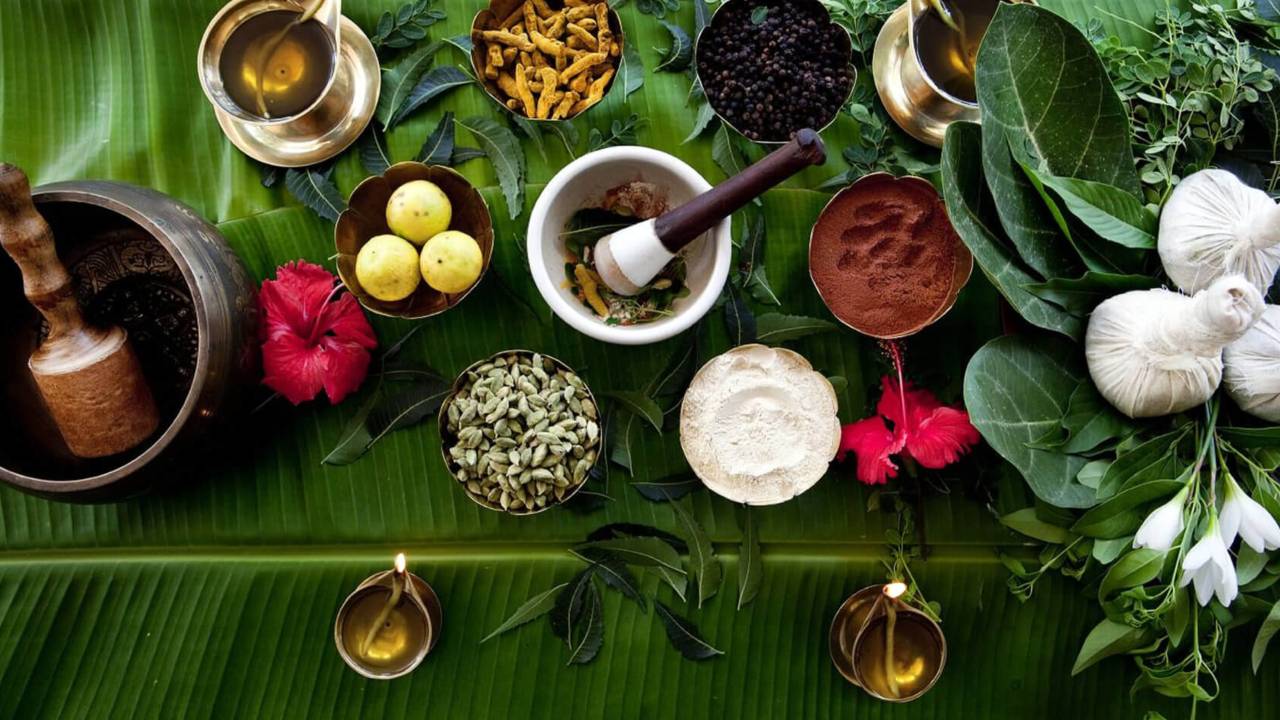Top 10 Ayurvedic Herbs With Their Great Benefits and Uses
Ayurveda, an ancient Indian system of medicine, is rooted in the philosophy of balance and harmony between the mind, body, and spirit. It emphasizes prevention and holistic well-being. For thousands of years, Ayurveda has relied on the therapeutic properties of plants to address various health concerns. These botanical treasures, often referred to as Ayurvedic herbs, form the cornerstone of this traditional healing system.
Ayurveda views health as a state of equilibrium among three fundamental energies or doshas: Vata, Pitta, and Kapha. Imbalances in these doshas are believed to lead to physical and mental ailments. Ayurvedic practitioners strive to restore balance through diet, lifestyle modifications, and the judicious use of herbs.
The Importance of Ayurvedic Herbs
Ayurvedic herbs are revered for their profound impact on promoting health and wellness. These botanical wonders are rich in vitamins, minerals, antioxidants, and other bioactive compounds that offer a wide range of benefits. They are used to:
- Boost immunity: Many Ayurvedic herbs possess immune-enhancing properties, helping the body ward off infections.
- Improve digestion: Digestive ailments are commonly addressed with Ayurvedic herbs that support healthy digestion and gut function.
- Manage stress and anxiety: Certain herbs are known for their calming and adaptogenic effects, helping to reduce stress and anxiety.
- Promote skin health: Ayurvedic herbs are used in skincare formulations to nourish, protect, and rejuvenate the skin.
- Support overall well-being: By addressing the root cause of imbalances, Ayurvedic herbs contribute to overall health and vitality.
Most Popular Ayurvedic Herbs Used in India
Ayurveda boasts a treasure trove of herbs, each with unique benefits. From stress-busting Ashwagandha to digestion-enhancing Triphala, these ancient remedies offer holistic wellness.
Addressing everything from immunity to skin health. In the following sections, we will delve deeper into specific Ayurvedic herbs, their properties, and traditional uses.
1.Turmeric (Curcuma longa)
Turmeric, a vibrant yellow spice derived from the root of the Curcuma longa plant, has been an integral part of Indian culture and cuisine for millennia. Its distinct color and earthy flavor have made it a beloved ingredient in various dishes, from curries to pickles. Beyond its culinary applications, turmeric has a rich history in traditional medicine systems, particularly Ayurveda.
Health Benefits
Turmeric’s golden hue hides a treasure trove of medicinal properties. The compound primarily responsible for its benefits is curcumin.
- Anti-inflammatory: Turmeric’s potent anti-inflammatory properties have been studied extensively. It is believed to help manage conditions like arthritis, inflammatory bowel disease, and skin inflammation.
- Antioxidant: Packed with antioxidants, turmeric helps combat free radicals, reducing oxidative stress and protecting cells from damage. This can contribute to overall health and longevity.
- Immune Booster: Turmeric has immune-modulating effects, helping to strengthen the body’s defense system. It is often used to support immunity during seasonal changes.
Common Uses in Ayurvedic Treatments
In Ayurveda, turmeric is considered a vital herb with a wide range of applications. Some common uses include:
- Digestive Health: Turmeric is believed to improve digestion, reduce bloating, and support liver function. It is often used in formulations for conditions like indigestion and irritable bowel syndrome.
- Skin Care: Turmeric has anti-bacterial and anti-inflammatory properties, making it beneficial for skin health. It is used in Ayurvedic skincare to treat acne, eczema, and other skin disorders.
- Joint Pain: Turmeric’s anti-inflammatory effects make it a popular choice for managing joint pain and stiffness associated with conditions like arthritis.
- Detoxification: Turmeric is considered a detoxifier, helping to cleanse the body of impurities. It is often used in panchakarma, Ayurvedic detoxification therapies.
2. Ashwagandha (Withania somnifera)
Ashwagandha, often referred to as “Indian ginseng,” is an evergreen shrub with a unique, horse-like odor, hence its name. Native to India, the Middle East, and parts of Africa, it has been a cornerstone of Ayurvedic medicine for centuries. The roots of the plant are primarily used for medicinal purposes.
Traditionally, Ashwagandha has been employed to:
- Enhance strength and vitality: Its name, translating to “horse smell,” suggests its reputation as a strength-building herb.
- Manage stress and anxiety: It’s been used to promote calmness and emotional balance.
- Improve sleep quality: Ashwagandha has been traditionally used as a sleep aid.
- Support reproductive health: Both men and women have used it to address fertility and sexual dysfunction.
Health Benefits
Modern research has shed light on the potential health benefits of Ashwagandha:
- Stress Reduction: Ashwagandha has shown promise in reducing cortisol levels, the stress hormone, leading to improved mood and overall well-being.
- Improved Energy Levels: By supporting adrenal function, Ashwagandha may help combat fatigue and increase energy levels.
- Enhanced Cognitive Function: Some studies suggest that Ashwagandha can improve focus, memory, and overall brain function.
Popular Ayurvedic Remedies and Preparations
Ashwagandha is available in various forms, including:
- Powder: The root is dried and ground into a powder, often mixed with honey or ghee for consumption.
- Capsules: A convenient form for daily supplementation.
- Tincture: An alcohol-based extract, offering quick absorption.
- Decoction: The roots are boiled in water to create a concentrated liquid.
Ashwagandha is often combined with other herbs in Ayurvedic formulations to address specific health concerns. For instance, it might be paired with Brahmi for cognitive enhancement or with Shatavari for reproductive health.
3. Tulsi (Ocimum sanctum)
Tulsi, revered as the “holy basil,” is an aromatic perennial plant with deep-rooted significance in Indian culture and religion. It’s recognized for its medicinal properties and is widely cultivated in home gardens and temples. There are three primary varieties: Rama Tulsi (bright green), Krishna Tulsi (purple), and Vana Tulsi (wild).
Beyond its spiritual importance, Tulsi holds a special place in the hearts of millions due to its numerous health benefits. It is often worshipped as a goddess and is believed to bring prosperity, good health, and spiritual upliftment.
Health Benefits
Tulsi is a powerhouse of antioxidants, vitamins, and minerals. Its therapeutic properties have been harnessed for centuries.
- Respiratory Health: Tulsi is renowned for its expectorant and anti-inflammatory properties, making it effective in treating respiratory ailments like cough, cold, bronchitis, and asthma.
- Stress Relief: Known for its adaptogenic qualities, Tulsi helps the body cope with stress, anxiety, and fatigue. It promotes mental clarity and relaxation.
- Immune Support: Rich in antioxidants, Tulsi strengthens the immune system, helping to protect against infections and diseases.
Common Uses in Ayurvedic Formulations
Tulsi is an indispensable herb in Ayurvedic medicine. It’s incorporated into various formulations to address a wide range of health issues.
- Digestive Health: Tulsi aids digestion, reduces bloating, and improves appetite.
- Skin Care: Its anti-inflammatory and antimicrobial properties make it beneficial for skin conditions like acne, eczema, and insect bites.
- Fever Reduction: Tulsi is often used to alleviate fever and reduce inflammation.
- Oral Hygiene: Tulsi-based mouthwashes and toothpastes are popular for maintaining oral health.
4. Amla (Emblica officinalis)
Amla, also known as Indian gooseberry, is a small, green fruit packed with nutritional power. It’s a cornerstone of Ayurvedic medicine, revered for its rejuvenating and healing properties. The entire plant, from roots to fruits, is considered beneficial. Amla is often referred to as the “Ayurvedic superfruit” due to its exceptional nutritional profile.
Health Benefits
Amla is a nutritional powerhouse with a myriad of health benefits.
- Rich in Vitamin C: It’s an excellent source of vitamin C, surpassing even citrus fruits. This vitamin is crucial for immune function, collagen production, and iron absorption.
- Antioxidant Properties: Amla is loaded with antioxidants that help protect cells from damage caused by free radicals, contributing to overall health and longevity.
- Digestive Health: It aids digestion, improves appetite, and supports liver function. Amla is often used to treat digestive disorders like constipation and acidity.
Ayurvedic Preparations and Uses
Amla is incorporated into various Ayurvedic formulations and consumed in different forms:
- Amla Juice: A popular and refreshing way to consume amla, often mixed with honey for taste.
- Amla Churna (Powder): Dried amla fruit is ground into powder, used in various Ayurvedic preparations.
- Amla Murabba: A sweet preserve made from amla, enjoyed as a snack or added to other dishes.
- Triphala: A classic Ayurvedic formulation composed of amla, bibhitaki, and haritaki, known for its detoxifying and rejuvenating properties.
- Hair Care: Amla is used in hair oils and shampoos to promote hair growth, prevent premature graying, and improve hair health.
Amla’s versatility and remarkable health benefits have made it a staple in Ayurvedic practices for centuries.
5. Neem (Azadirachta indica)
Neem, often referred to as the “miracle tree,” is a versatile plant native to India. It has been a staple in Ayurvedic medicine for centuries due to its remarkable healing properties. Nearly every part of the neem tree, from its leaves to its bark, is utilized for medicinal purposes.
Traditionally, neem has been employed to:
- Treat skin diseases: Neem is renowned for its ability to soothe skin irritations, heal wounds, and treat skin infections.
- Manage dental issues: Neem twigs are often chewed to promote oral hygiene and prevent gum diseases.
- Control pests: Neem-based products are effective in repelling insects and controlling pests.
- Support digestive health: Neem is believed to aid digestion, reduce inflammation in the gut, and treat digestive disorders.
Health Benefits
Modern research has validated many of neem’s traditional uses:
- Antibacterial and Antifungal: Neem possesses potent antibacterial and antifungal properties, making it effective against various infections.
- Skin Health: Neem helps in treating acne, eczema, psoriasis, and other skin conditions.
- Immune Booster: It is believed to strengthen the immune system and protect against diseases.
- Anti-inflammatory: Neem has anti-inflammatory properties that can help reduce inflammation throughout the body.
Common Ayurvedic Applications
Neem is a versatile herb used in various Ayurvedic formulations:
- Neem Oil: Extracted from neem seeds, it is used for skin care, hair care, and as a natural insect repellent.
- Neem Leaves: Dried neem leaves are often brewed into tea to treat digestive issues and fever.
- Neem Bark: Used in decoctions for skin diseases and liver disorders.
- Neem Toothpaste and Mouthwash: Neem-based oral care products are popular for maintaining oral hygiene.
Neem’s multifaceted benefits and its sustainable nature have made it a valuable resource in both traditional and modern healthcare.
6. Ginger (Zingiber officinale)
Ginger is a tropical plant renowned for its pungent and aromatic rhizome (underground stem). Native to Southeast Asia, it has been cultivated and used for thousands of years. Its history is intertwined with trade routes, as ginger was a prized commodity in ancient civilizations. The Greeks and Romans valued it for its medicinal properties and flavor, while in the Middle Ages, it was considered a luxury item.
Health Benefits
Ginger has been cherished for its therapeutic properties. Key benefits include:
- Digestive Aid: Ginger is well-known for its ability to soothe upset stomachs, reduce nausea, and improve digestion. It is often used to alleviate symptoms of indigestion, bloating, and loss of appetite.
- Anti-inflammatory: Ginger contains compounds with anti-inflammatory properties, which can help reduce inflammation associated with various conditions.
- Nausea Relief: Ginger is effective in managing nausea, particularly during pregnancy and chemotherapy. It can also help alleviate motion sickness.
Ayurvedic Uses and Remedies
In Ayurveda, ginger holds a prominent position. It’s considered a warming and stimulating herb with numerous applications:
- Balancing Vata: Ginger is believed to balance the Vata dosha, which is associated with dryness, cold, and imbalance.
- Digestive Disorders: Ginger is used to treat a variety of digestive ailments, including indigestion, bloating, and loss of appetite.
- Cold and Flu: Ginger tea is a popular remedy for relieving cold and flu symptoms, as it helps clear congestion and reduces inflammation.
- Pain Relief: Ginger is applied topically or consumed orally to alleviate muscle and joint pain.
- Boosting Circulation: Ginger is believed to improve blood circulation, which can benefit overall health.
Ginger is a versatile ingredient used in various Ayurvedic preparations, including teas, infusions, and herbal supplements. Its pungent flavor and numerous health benefits make it a valuable addition to any wellness regimen.
7. Brahmi (Bacopa monnieri)
Brahmi, often referred to as the “herb of grace,” is a creeping, aquatic plant with small, oval-shaped leaves. It thrives in wetland environments and is native to India, but can also be found in other parts of the world. In Ayurveda, Brahmi is highly revered for its profound impact on mental health and cognitive function. It is believed to nourish the brain, improve memory, and promote calmness.
Health Benefits: Cognitive Enhancement, Stress Reduction, Memory Support
Brahmi has gained significant attention for its potential cognitive benefits:
- Cognitive Enhancement: It is believed to improve memory, concentration, and learning abilities.
- Stress Reduction: Brahmi is often used as an adaptogen to help the body manage stress and promote relaxation.
- Memory Support: Its ability to enhance cognitive function makes it a popular choice for supporting memory, especially as we age.
Ayurvedic Preparations and Applications
Brahmi is available in various forms, including:
- Powder: Dried Brahmi leaves are ground into a fine powder, often mixed with honey or ghee.
- Capsules: A convenient form for daily supplementation.
- Tincture: An alcohol-based extract for quick absorption.
In Ayurveda, Brahmi is often combined with other herbs to create synergistic formulations. It is commonly used in:
- Medhya Rasayana: Ayurvedic formulations designed to nourish the brain and improve intelligence.
- Antianxiety and Anti-stress Formulas: Brahmi is included in herbal blends to promote calmness and reduce anxiety.
- Child Development: Brahmi is often given to children to support cognitive development and improve focus.
It’s important to note that while Brahmi has shown promise in research, individual responses may vary. It’s advisable to consult with an Ayurvedic practitioner before starting any new herbal supplement.
8. Shatavari (Asparagus racemosus)
Shatavari, meaning “one hundred husbands” in Sanskrit, is a perennial climbing plant native to India. It has deep cultural significance, particularly in Ayurvedic medicine, where it’s considered a rejuvenating and nourishing herb for women. Often referred to as the “queen of herbs,” Shatavari has been used for centuries to support women’s health and well-being.
Health Benefits: Reproductive Health, Hormonal Balance, Lactation Support
Shatavari is renowned for its beneficial effects on the female reproductive system:
- Reproductive Health: It’s traditionally used to promote fertility, regulate menstrual cycles, and alleviate menopausal symptoms.
- Hormonal Balance: Shatavari is believed to help balance hormones, supporting overall reproductive health.
- Lactation Support: It’s often used to increase milk production in breastfeeding women.
- Digestive Health: Shatavari also possesses digestive properties, helping to soothe the stomach and improve digestion.
Common Ayurvedic Treatments
Shatavari is a key ingredient in numerous Ayurvedic formulations:
- Aphrodisiacs: Shatavari is considered a natural aphrodisiac and is often used to enhance libido and sexual desire.
- Rasayana Tonics: These rejuvenating formulas help restore vitality and promote longevity.
- Digestive Remedies: Shatavari is included in formulations to support digestion and alleviate stomach discomfort.
- Lactation Boosters: Shatavari is a core ingredient in herbal blends designed to increase milk supply.
It’s important to note that while Shatavari is generally considered safe, it’s advisable to consult with an Ayurvedic practitioner before using it, especially during pregnancy or breastfeeding.
9. Triphala
Composition: Amalaki (Amla), Bibhitaki, HaritakiTriphala is a cornerstone of Ayurvedic medicine, composed of three potent fruits:
- Amalaki (Amla): Rich in vitamin C and antioxidants, it supports immunity and digestion.
- Bibhitaki: Known for its detoxifying and rejuvenating properties.
- Haritaki: Often called the “king of herbs,” it is believed to balance all three doshas (Vata, Pitta, Kapha).
Health Benefits: Detoxification, Digestive Health, Antioxidant Properties
Triphala is renowned for its:
- Detoxifying properties: It helps cleanse the body of impurities and supports liver function.
- Digestive health: Improves digestion, relieves constipation, and supports gut health.
- Antioxidant power: Protects cells from damage caused by free radicals.
- Immune support: Boosts immunity due to its high vitamin C content.
Traditional Ayurvedic Uses
Triphala is used in a variety of ways:
- Digestive issues: Treats constipation, indigestion, and bloating.
- Detoxification: Supports liver and colon cleansing.
- Oral health: Improves gum health and freshens breath.
- Skincare: Used in topical applications for skin conditions.
- Weight management: This may aid in weight loss as part of a healthy lifestyle.
Triphala is often consumed as a powder mixed with water or honey, or in capsule form. It’s important to consult with an Ayurvedic practitioner for personalized guidance.
10. Guggulu (Commiphora mukul)
Guggulu is a resin obtained from the Commiphora mukul tree, native to India. It has been a cornerstone of Ayurvedic medicine for centuries. The resin is typically collected by making incisions in the tree’s bark, allowing the resin to ooze out and solidify.
Traditionally, Guggulu has been used to:
- Treat joint pain and inflammation: It is considered effective in managing conditions like arthritis.
- Manage skin conditions: Guggulu is used in Ayurvedic formulations for skin diseases like psoriasis and acne.
- Support weight management: It is believed to help in reducing body weight and cholesterol levels.
Health Benefits: Anti-inflammatory, Weight Management, Cholesterol Regulation
Modern research has supported some of Guggulu’s traditional uses:
- Anti-inflammatory: Guggulsterones, the active compounds in Guggulu, have potent anti-inflammatory properties.
- Weight Management: It may help in reducing body weight by supporting metabolism.
Cholesterol Regulation: Some studies suggest that Guggulu can help lower LDL (bad) cholesterol levels.
Common Ayurvedic Remedies
Guggulu is a key ingredient in many Ayurvedic formulations:
- Arthritis medications: It’s included in herbal combinations to manage joint pain and inflammation.
- Skin care products: Guggulu-based creams and ointments are used for various skin conditions.
- Weight management supplements: It’s often combined with other herbs to support weight loss efforts.
It’s important to note that while Guggulu has shown promise in research, it’s essential to consult with an Ayurvedic practitioner before using it, as it might interact with certain medications.
Ayurveda’s holistic approach and emphasis on prevention make it increasingly relevant today. By blending ancient wisdom with modern science, we can harness its potential for improved health and well-being.

























